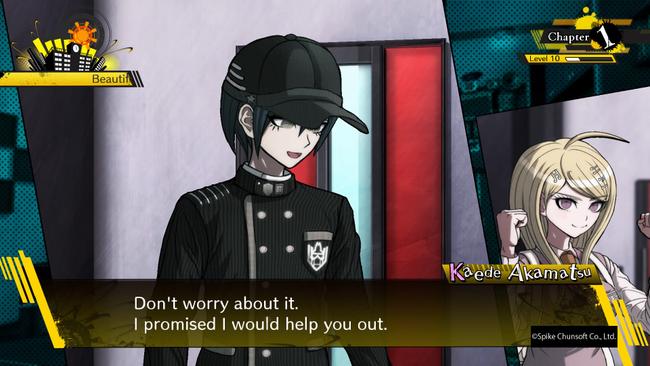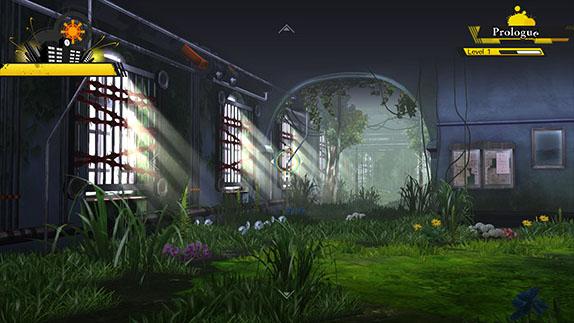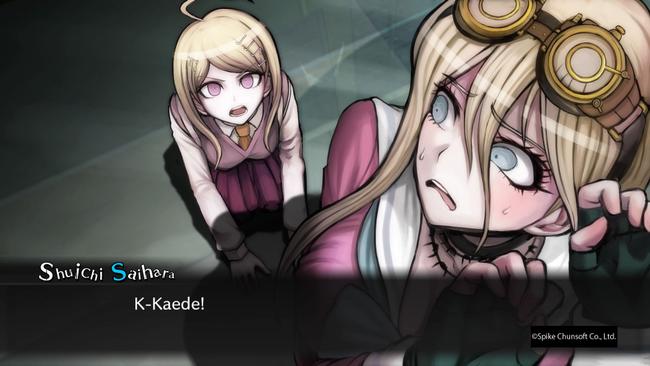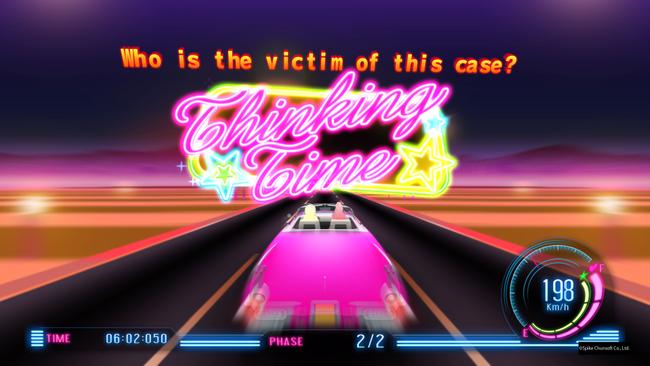
Danganronpa V3: Killing Harmony Review
A murder mystery is a tough thing to successfully pull off, especially in a franchise like Danganronpa where it's one of the core appeals of the series. Which brings us to Danganronpa V3: Killing Harmony, a game that marks a new beginning of sorts for the beloved franchise, while also trying to surprise a fanbase that’s really seen it all. The road to hope and despair is paved with good intentions, but unfortunately Killing Harmony struggles to not veer off into a ditch.
Disclaimer: Danganronpa V3 is a murder mystery whodunit affair, which is to say it is a very plot-heavy game. The big appeal of Danganronpa games are the class trials and trying to piece together all the mysteries in your head. You can breathe easy reading this review though, as it will only discuss the contents of the first chapter and will be entirely spoiler free. Even the big story beats of chapter 1 won't be mentioned here.
Danganronpa V3 begins with the series tradition of bringing together 16 exceptional high school students and pitting them against one another. Each student has their own unique talent, and they are dubbed ‘Ultimates’. An example being the character Himiko Yumeno is the Ultimate Magician.

Though this is by no means a friendly competition, as these 16 students were all kidnapped and brought to their new school by longtime series villain Monokuma and forced to participate in his ‘killing game’. Basically, they’re trapped at his Ultimate Academy For Gifted Juveniles, and if they want to escape the clutches of the bloodthirsty bear, they’ll need to murder each other and not get caught. After each murder, Monokuma will bring all the students together in a class trial to determine the identity of the culprit. If they gather the correct evidence and identify the culprit, Monokuma will execute them. However, if they choose the wrong person as the culprit, Monokuma will execute everyone else and let the murderer go free. The idea is to divide the students and have an air of mistrust among the Ultimates.
Of course, if you’ve played the previous games then this is all going to sound fairly bog standard. The formula of Danganronpa V3 isn’t much different from that of Danganronpa: Trigger Happy Havoc and Danganronpa 2: Goodbye Despair. A chapter will begin, you’ll get some downtime to spend with your classmates, a murder will happen, an investigation will begin, and then the class trial will start.
Unfortunately, this where the problems I have with Danganronpa V3 begin to surface, and it’s two-fold. The first being the cast isn’t nearly as interesting as those of the past games, and secondly, the running time of the game is hideously drawn out.
Let’s tackle the first issue I have: the characters. I really had a hard time connecting with and feeling for most of the cast. A couple of them are great, like Kokichi Oma the Ultimate Supreme Leader. A youngster that consistently will keep you on your toes with his devilish smile, unable to get a read on whether he is friend or foe. Or Himiko Yumeno, the Ultimate Magician, who's utter apathy during every conversation is oddly endearing.

However, most of the cast just falls flat. For example Gonta Gokuhara the Ultimate Entomologist’s whole shtick is to speak like a primitive that doesn’t understand most social cues. He was apparently raised by wolves and as a result, his dialect is of that ‘Me-Jane-you-Tarzan’ variety and it gets old really quick.
Whichever characters you like or dislike is obviously a subjective take, but the ratio is in stark contrast to the prior games in the series. It felt like most of the new cast were either trying too hard to be funny or were character tropes we’ve seen multiple times already. In Danganronpa 2: Goodbye Despair I loved nearly every character and feared for their safety the entire time. In a murder mystery, it’s kind of important that the player cares about the fate of the characters involved whether they’re victims, the culprit, or just onlookers caught in the shuffle. All the twists and whodunit tropes in the world can’t make the situation tense if you can't bring yourself to care. One of the chapters later in the game embodied all of this to a tee and it was difficult to sit through.
Now onto my second big gripe with Danganronpa V3, the pacing. This game is staggeringly drawn out and long, to the point where I can’t believe a script editor at Spike Chunsoft didn’t edit it down. Just the prologue and first chapter probably take you upwards of 7 hours to complete. Every scene, plot detail, joke/zinger, and gameplay element is needlessly drawn out to the point where it’s frustrating and obnoxious. Now most visual novels are pretty long in the tooth, even Danganronpa 2 was fairly lengthy, but Killing Harmony is just on another level. There is one chapter in this game that, no exaggeration, took well over 9 hours to complete. That’s nearly half the length of the original Danganronpa. I have no problem with the game being long, but what I do have a problem with is needless padding. Some of the most basic plot details are poured over repeatedly to the point where it felt like the game was nagging me over the 55 hours it took to complete.
When you couple a mostly uninteresting cast with a very stretched out run time, it makes for a game that is aggressively boring at times. The core issue here is the writing, it’s just not up to snuff with the other two mainline Danganronpa games as a whole. Probably the biggest compliment I can give the first two games is that they were legitimately humorous in a way you rarely see in games, the second game, in particular, was laugh-out-loud hilarious. Danganronpa V3 on the other hand rarely made me even crack a smile, although it has its moments and Monokuma himself is on point as always. Overall it feels so joyless like the game is just going through the motions.
The challenge of reviewing a murder mystery like Danganronpa V3: Killing Harmony is you have got to keep the plot details completely vague if you don’t want to spoil it for the reader. There are some moments in this game that are bound to be very divisive. Killing Harmony will wildly swing some heavy plot beats at you, and whether or not they land successfully is entirely up to the audience. In my eyes, I was left flabbergasted and deeply disappointed at some of the directions the story decided to go. To me, Danganronpa is supposed to be glorious, funny, and awesome; not cowardly, tiring, and boring. Killing Harmony was in the latter camp for a good clip of the runtime.

One aspect of Danganronpa that hasn’t lost its footing in the transition to Killing Harmony is the music. Longtime series composer Masafumi Takada is on point as always, and it’s truly difficult to get some of these tracks out of your head. There’s a wealth of music he created for this game, and the new tracks hold up very well against the iconic stuff from previous games. Whether it’s setting the stage during a class trial or revealing the horror of a murder, Takada’s music just nails the mood all throughout.
All the prior Danganronpa games I had played on the Playstation Vita, and I was a bit concerned that the formula wouldn’t transition well to the PS4 and a TV screen. Thankfully I was proven wrong, and Danganronpa V3: Killing Harmony works as well on a console as prior entries did on VIta. It’s by no means a technical showpiece, and it still looks like a Vita game at heart, but the higher quality assets make up for it. There’s a lot more pizazz to the animations and just general traversal that makes the environments pop out more. The presentation as a whole has improved a good deal since the first two games.
Being a visual novel, a good majority of Danganronpa V3: Killing Harmony doesn’t feature mechanically complex gameplay. Whether you’re spending time with your fellow classmates during free time events or gathering clues for a class trial, most of the gameplay amounts to just examining items and talking to the other characters. That is until you get to the class trials themselves, where thankfully the minigames involved have improved since the last game for the most part. In previous games, you could use ‘truth bullets’ to punch holes in someone’s argument. Now you can use ‘lie bullets’ to shake up your opposition a bit and send them down the wrong path, and also to eventually get to the truth of an argument.
What’s even more enjoyable is the new Scrum Debate mechanic, where two teams of characters in a class trial will face off against each other. It adds a little bit more humanity to trials that were lacking in the previous games, as I think if people were actually involved in one of Monokuma’s trials that there would be a lot more finger pointing and taking sides.
Despite my general indifference towards many of the cast members, the Class Trials themselves were probably the most well thought out of the series. There wasn’t a moment where I felt like I was just throwing ideas at the wall hoping a point would stick (eg: gravel in a swimsuit from the second game). Everything fit together pretty logically and Spike Chunsoft has definitely improved since the first game.

On a mechanical and logical level anyway. However, there was this nagging feeling I got as I progressed through the game that the developers were struggling to come up with new ways to excite the audience during a class trial, to the point where some plot elements felt like an act of desperation to be shocking. Some of the most well-recognized whodunnit fiction out there tends to focus on the death of a single victim or the acts of a single murderer, meanwhile, Danganronpa has both several times over in each game. So it’s not surprising that the series has got to this point, however unfortunate that may be. For my money, I would rather have interesting characters and a good story than to just be shocked for the sake of it.
Danganronpa V3: Killing Harmony is destined to be a title the fans are going to be split over. The game has a very clear message it wants to rub off on the player, and it’s the sort of thing you’re going to have to mull over for a while to determine whether or not it earns its thesis. For me, it all just felt like desperation laced with fatigue. When the game wasn’t dragging me through incredibly long-winded exposition and plot bits, it was disappointing me with the direction the story took. If Spike Chunsoft wanted me to get a sense of closure from the series, they may have succeeded, because I’m not sure I’m up for another one.